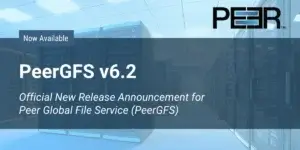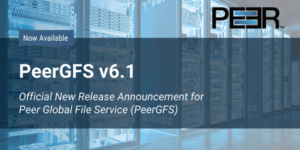Executive Summary: The Top Challenges of Enterprise File Migrations
Server migration can be a scary phrase to mutter in the IT world. Learn how to overcome the top challenges with Peer Software. Offering you an easy solution!
Overcoming the Top Challenges of File Migrations
Say the terms “data migration” or “file server migration” around your IT department, and you might cause a panic. For many industry professionals, the mere mention of WAN, LAN, and cloud data migrations implies sizable logistical hurdles to overcome. The process involves taking inventory of your current file storage infrastructure, and it begs the question, “How easy will the process be?”
According to Forbes, 36% of all migration efforts adhere to their original budget, while only 46% are completed according to schedule. If your team is unprepared, or is not using the right migration toolkit, the process can be arduous. But for those with the right LAN, WAN, and cloud migration tools for the job, migrating a file to a new server doesn’t have to be difficult.
Below are core file server migration challenges along with best practices for overcoming migration adversity.
1. Minimizing Cutover Time by Eliminating the Final Scan
Flipping the switch between your old file server and your new server can be a nail-biting experience. If your cloud migration strategy lacks the proper resources, there can be gray area situated in between the old and new systems. That gray area means increased potential for data loss.
More traditional migration solutions require a cutover time that often lasts hours, or sometimes days, due to a final scan of the old file server. PeerSync, on the other hand, utilizes its real-time replication engine to copy data immediately, even as changes occur. The net result is cutover time that takes minutes rather than hours.
2. Inventorying Your Existing File Storage with Pre-migration Analysis
As the old saying goes, “You have to know where you come from to know where you’re going.” The adage holds true for file server migration as well. The modern-day data storage is populated by millions, and in an ever growing number of cases, billions of files that work in conjunction to power your applications. When preparing a WAN, LAN, or cloud migration strategy, scanning the entire file directory’s tree depth can add time to the migration process.
Peer Software’s free-to-use file system analyzer (PeerFSA) helps you dig into the “black box” of storage so that you have a clear and detailed understanding of your file system ahead of time. That way you can formulate the best WAN or LAN migration strategy with the characteristics of each data type in mind.
3. Controlling the Process with Detailed Activity Reporting and Status Displays
Migration of servers from one data center to another can be potentially time-consuming depending on the migrations service you use. The last thing you want to be is in the dark during the process. You want a solution that is more than just a status bar; you want a solution with a robust dashboard that’s capable of reporting on a wide range of metrics that keep you informed throughout the file migration process.
4. Regulating Performance and Bandwidth Throttling
One of the biggest data center migration challenges is the fact that your business must continue during the migration itself. You need a migration solution that allows you to allocate key system resources as you see fit.
PeerSync includes a read/write buffer and bandwidth throttling tools that allow you to adjust the throughput speed of your data transfer on an as-needed basis. This ensures that business-critical functions remain in operation during the migration process.
5. Reorganizing Key Data During Transfer
Day-in, day-out usage makes your file server cluttered over time. The file server migration process is the time to reorganize and clean house. Through PeerSync’s data migration features, you can fix your key data structures by moving and laying out files and folders differently onto the new file server.
6. Creating Custom Migration Jobs
One of the biggest challenges of data center migration is the sheer amount of file path names involved in even the smallest migration. When you are working with hundreds or thousands of file path names, the process can grind to a halt.
PeerSync helps automate that process by allowing you to import file path names and build a list from there. You can set up your own custom jobs easily and quickly without the time spent on manual input.
7. Safeguarding Against Network and Server Outage
Experiencing any interruption to your network or server can be devastating in the midst of a LAN, WAN, or cloud migration process. At worst, it could result in data loss. At best, you might have to start the process over again.
To give your process a suitable level of resilience, you should seek a migration solution that runs as a service, like PeerSync. Our file migration suite allows you to customize failover parameters and suspend the migration job until the networking connection resumes, at which point it can automatically continue from where it left off.
8. Maintaining NTFS Permissions
Not every employee in your organization needs access to every file. The NFTS permissions that you set up allow you to share files with other stakeholders on a need-to-know basis. It can take time and effort to establish file permissions. With its robust set of file sharing options, PeerSync can help your organization maintain the safety and integrity of sensitive files by migrating permissions onto the new file server.
9. Navigating Open File Management
In the event of a time-intensive file migration process, you don’t want users to be locked out of critical documents and files. Open files can create a wrinkle in the migration process, however. Your migration service must be able to accommodate multiple scenarios to ensure core business functions and data integrity remain.
Worry-free File Server Migration
Moving from server to cloud, or server to server, can be a complicated, time-consuming task. It requires preparation and an awareness of the proper server migration steps in order to ensure that your business’ key data remains safe and intact.
While there are dozens of variables and contingencies to consider when performing a migration, you ultimately want a migration service that promotes resiliency while minimizing potential downtime. PeerSync’s suite of features can help you overcome all common migration challenges. For more information on our products and solutions, please contact us today.
Spencer Allingham
A thirty-year veteran within the IT industry, Spencer has progressed from technical support and e-commerce development through IT systems management, and for ten years, technical pre-sales engineering. Focusing much of that time on the performance and utilization of enterprise storage, Spencer has spoken on these topics at VMworld, European VMUGS and TechUG conferences, as well as at Gartner conferences.
At Peer Software, Spencer assists customers with deployment and configuration of PeerGFS, Peer’s Global File Service for multi-site, multi-platform file synchronization.
- Spencer Allingham#molongui-disabled-link
- Spencer Allingham#molongui-disabled-link
- Spencer Allingham#molongui-disabled-link
- Spencer Allingham#molongui-disabled-link







